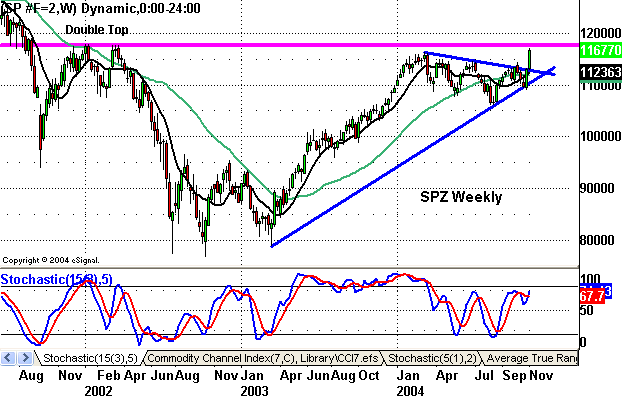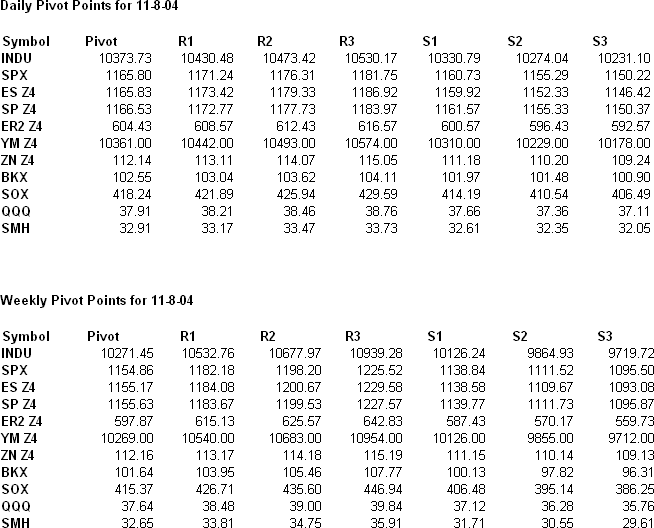Things Look Good, But There Is One Problem…
The equity markets posted solid gains last week,
largely due to President Bush being re-elected. In addition, Friday’s
Employment Report surprisingly strong and Crude Oil trended lower during the
week, which both added to the positive sentiment. The move higher was extremely
broad-based in nature, as overall breadth was the strongest we have seen in some
time. Even more positive was the technical
breakout in the SP 500 on
Friday. The index finished at a new closing high for 2004, thanks to renewed
strength in cyclical and financial shares. In other markets, bonds lost ground
(yields rose) as a result of hopes of a stronger economy. Meanwhile, the U.S.
Dollar unfortunately recorded a new all-time low versus the Euro, because of
escalating concerns about the budget and trade deficits. Gold finished at its
highest level in 16 years, which was mostly likely a function of weakness in the
greenback.
The
December SP 500 futures closed out the week with a gain of +37.50 points, while
the Dow futures surged another +386 points. On a weekly basis, the contract
broke its triangle pattern and is facing double-top resistance going back to
Jan/March ’02. Looking at the daily charts, the ES posted a new yearly high,
but finished with a spinning top. Open interest did increase again in Friday’s
session, which could be indicative of fund performance-chasing. The YM cleared
its weekly downtrend line to close at an 8-week high. For you 3-Line Break
followers, both the ES and YM break prices moved up to 1130.75 and 10042
respectively. In the small caps, the ER2 is forming a weekly cup as it closed
at a new all-time high.
                   
With
President Bush’s decisive victory, many market players are now expecting
dramatic reform. Issues such as simplifying the Tax Code and revamping Social
Security are expected to take center stage in the years to come. As far as
taxes go, it would not surprise me to see initiatives to lower income and
investment taxes, while attempting to install a National Sales Tax. This type
of action would be focused towards increasing investment and savings, and also
decreasing spending and debt accumulation. Because of the demographics of the
U.S, a very serious long-term problem exits in the form of low savings and way
too much outstanding debt. The Social Security system has also been an issue of
great debate for years. It’s no mystery that in its current form, there is no
way that future generations will be able to reap the same retirement benefits
that are being received today. President Bush has hinted towards privatizing
Social Security, and if this were to take place, individuals would be able to
use new retirement funds towards investing in the stock market (likely in index
products). Consequently, if privatization ever passes, there could be a lot of
buying down the road for stocks.
While
things sounds great at the moment, there is one problem lurking. That problem
is the huge budget deficit, which could restrict some of the ability to make
changes down the road. Some “experts†say that deficits don’t matter as much.Â
Perhaps, in the short-term, that may be the case. But in the long run it’s
pretty naive to suggest that debt levels are not important. When the price of
our currency continues to decline during a time of economic growth and rising
short-term rates, that is not exactly a healthy sign. Moving forward, we’ll
want to pay close attention to the strength (or weakness) of the U.S. dollar.Â
The first hint may come with Tuesday’s FOMC Meeting. While short-term rates are
expected to be raised another 25 bps to 2%, the big question is what Greenspan
and Co. have in store for us after that.
 Â

Â
Please feel free to email me with any questions
you might have, and have a great trading week!
Â
Â
Â
Â
